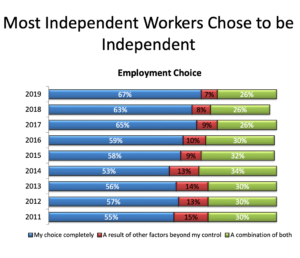July has been a month all about independent entrepreneurs – with a bill that is getting lots of media attention and two CAMEO activities promoting success for independents.
Policy
AB 5 (Gonzalez) is a bill working its way through the California legislature that will re-define how employees and independent contractors are defined.
AB 5 reinforces protections for misclassified workers, assists in holding underground contractors accountable, fights the underground economy, restores tax revenues for unemployment/disability insurance and protects law-abiding contractors from being at a competitive disadvantage. However, some say the bill would be better if there were more industries/professions listed in the bill that traditionally operate as independent contractors.
So far, AB 5 exempts licensed insurance agents, certain licensed health care professionals, registered securities broker-dealers or investment advisors, a direct sales salesperson, real estate licensees, workers providing hairstyling or barbering services, and those performing work under a contract for professional services.
The bill seems positive for many gig workers, but if it goes unchanged it will make defining work more complicated for a lot of independent contractors.
CAMEO Activities
CALED hosted CAMEO on a webinar on the ‘Gig Economy’. Four myths of independent entrepreneurs according to Steve King and the 2019 State of Independence report include:
 Myth: They lost their job and were forced into it
Myth: They lost their job and were forced into it
Reality: The majority of people choose independent work
Myth: People who are independent entrepreneurs don’t like the work
Reality: They are satisfied 76% are very satisfied or satisfied and the number of people not satisfied has been declining.
Myth: People would rather have a traditional full-time job.
Reality: Independents have it better now and they plan to stay independent.
Myth: Independent entrepreneurs don’t make much money.
Reality: Full-time independents earn an average of $68,000 with a median of $40,000 which is comparable to traditional jobs.
Also on the webinar was Aurelie Douret from Samaschool talking about their beginning class on how to succeed as a freelancer. As part of our USDA grant, we offered members who attended a train-the-trainer orientation on the gig economy and the tools to implement the Samaschool curricula. Michelle Skilljan of the Inland Empire WBC held an initial class in which her clients learned how to build profiles and successfully market themselves online. Trish Funk from JEDI’s WBC started her class in Redding yesterday.
If you’re interested in learning more about our partnership with Samaschool and offering classes on freelancer success to their clients, email Heidi.
